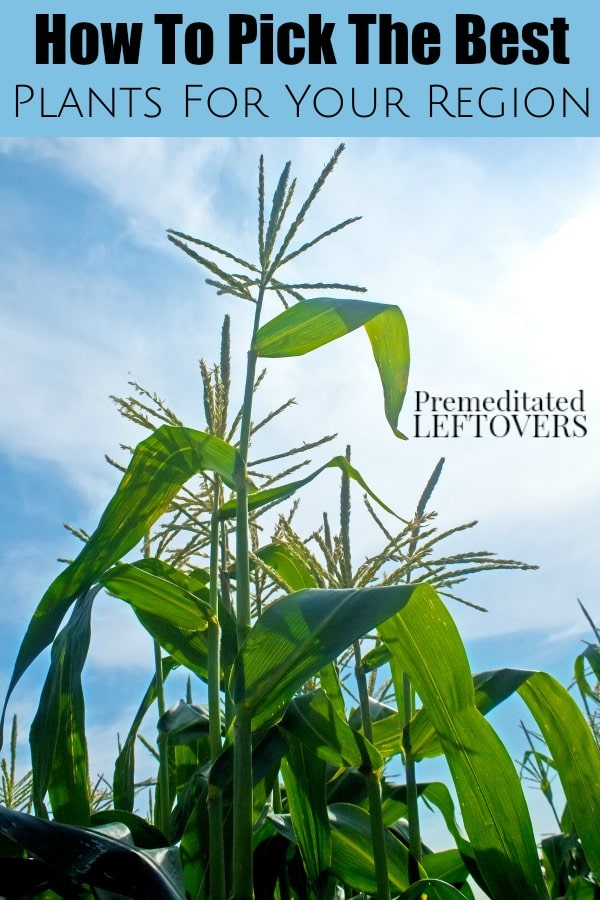As you begin to plan your summer vegetable garden, use these tips on How to Pick the Best Plants for Your Region. Planting a wonderful vegetable plant in the wrong place will only give you frustration and no yummy foods to eat.
Knowing how to pick the best plants for your region can be the make or break method behind your summer garden. While you may want to grow all kinds of vegetables, the reality is that not every location is ideal for every plant. Some places are perfect for growing exotic vegetables while others will be nearly impossible to grow. Work within these guidelines and learn How to Pick the Best Plants for Your Region.
How To Pick The Best Plants for Your Region
Research rainfall during growing seasons. One of the biggest impacts on your crop of vegetables is going to be the amount of water you are able to provide your backyard garden with easily. In areas with much drier climates, plants that require less watering are best for being cost-effective. If you are spending more money on watering your garden than you are saving on growing your own produce it isn’t a good budgetary plan.
Take a look at the statistics for rainfall during peak growing seasons for your area over at least the past 5 years. Next, you’ll want to look for the plants that do well in either dry or wet areas. Many crops require daily watering. They may be too costly for you to provide water for in a dry climate. Others, like cactus varieties are ideal for a dry climate. Understanding the rainfall that is average for your area is important for providing your plants with the right amount of water while staying within your budget.
Learn how climate and temperature affect your plants. There are many plants that require a certain temperature range to thrive. Some do well in cooler temperatures and will refuse to produce fruits when they are over 90 degrees on a regular basis. Others don’t produce well in temperatures under 60 degrees. This is really important to consider if you live in the North or deep South. Areas like the southern states where you have extremely high temperatures that reach well above 90 degrees during the summer can easily kill plants even when they are being watered regularly Other areas like the Pacific North West may have extremely low temperatures in the 50’s or 60’s at night and thus could damage some plants that require higher temperatures to produce fruits.
Check out temperature patterns along with rainfall for your peak growing season. This will help you pick plants for the right local temperatures. Some plants work in nearly any conditions, while others thrive best in warmer or cooler climates.
Be realistic about the amount of shade or sunlight you have to offer. If you live in an area that has no shade to offer your plants, you may need to be careful about what you choose to plant and where. If you live in the dessert with direct sunlight all around your garden, you need hearty plants that want lots of sunshine. If you live in a wooded area that has a lot of shade later in the day, a plant that likes less direct sunlight is ideal.
Take the time to notice the areas of shade and direct sunlight in your gardening spot. You’ll easily be able to tell if your backyard garden is better for plants that require a lot of sunshine, a lot of shade, or a little of both.
Pick native plants. While you will probably want to plant a large variety of vegetables or flowers in your garden, you can begin by checking out the native plants to your region. Things that grow naturally in your region, were discovered in your region, or have been adapted to your region and thrive are ideal.
You can ask the local gardeners club or even look at simple statistical information about your state and area to find this information. Just like we know that Palm Trees are commonly found around coastal areas, you’ll know that cactus is found in dessert areas. These are native plants, that while able to grow outside their region are best grown in that climate. Once you figure out your native plants, you can make the most of them and other similar plant species in your own garden.
Read the Almanac. One of, if not the best tool, for learning about the best plants for your region is the Farmer’s Almanac. Spend time each year studying recommend planting times, patterns, and best tips for your particular region. This tool has been a wonderful resource for a reason. It pulls statistics and gives you the best averages and information in one simple location.
Ask your local nursery. While a local nursery or garden center is likely to have a ton of varieties, they are also going to know a bit more about what thrives in your region. A standard garden center is likely to have more of specific varieties, but their employees may not be very knowledgeable. For real knowledge, seek out the staff at a local nursery or greenhouse. You may even consider checking in with the agricultural department of any local college in your region. They are usually more than happy to share information about their studies with those interested in the community.
These tips on How to Pick the Best Plants for Your Region are just the beginning of creating a stunning garden this year. Whether your backyard garden includes flowers or vegetables, knowing the best plants for our region is important for long term growing success.
More Gardening Tips:
10 Raised Garden Bed Ideas for Easier Gardening
Container Gardening in Small Spaces


Leave a Reply